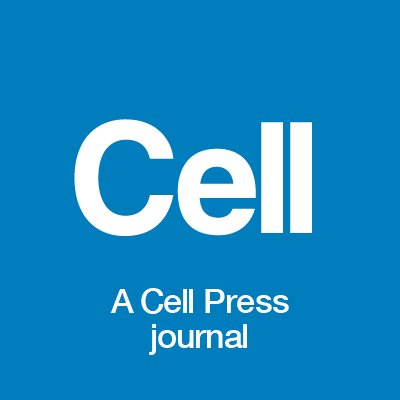
Cell
@CellCellPress
Followers
264K
Following
361
Media
4K
Statuses
13K
Cell aims to publish the most exciting and provocative research in biology. Posts by Scientific Editors on the Cell Editorial team.
Cambridge, MA
Joined August 2009
New issue is out! 👉 https://t.co/QYWhLYBU9p On the cover: Zhu et al. uncover key genes underlying soybean adaptation and improvement.
1
5
22
In the latest issue! Astrocytes functionally integrate multiple synapses via specialized leaflet domains
cell.com
Volumetric high-resolution electron microscopy reveals thin astrocyte leaflets form gap-junction-interconnected domains that contain minuscule endoplasmic reticulum saccules and enwrap synapses in...
0
3
15
In the latest issue! Creeping fat-derived mechanosensitive fibroblasts drive intestinal fibrosis in Crohn’s disease strictures
cell.com
A pro-fibrotic, mechanosensitive CTHRC1+ fibroblast population derived from creeping fat drives intestinal fibrosis in Crohn’s disease.
0
9
33
In the latest issue! Chimeric infective particles expand species boundaries in phage-inducible chromosomal island mobilization
cell.com
Capsid-forming PICIs (cf-PICIs) produce their own capsids and exploit phage tails from unrelated species to transfer their DNA across bacterial hosts. This tail piracy enables broad dissemination and...
0
2
14
In the latest issue! AI mirrors experimental science to uncover a mechanism of gene transfer crucial to bacterial evolution
cell.com
By solving a previously unsolved biological question, the AI co-scientist predicted a complex mechanism of gene transfer and generated hypotheses that opened new research directions, illustrating...
0
3
7
In the latest issue! Culture-independent meta-pangenomics enabled by long-read metagenomics reveals associations with pediatric undernutrition
cell.com
Minich et al. hypothesized that complete metagenome-assembled genomes, recovered through long-read DNA sequencing, would enable pangenome and microbial genome-wide association analyses to identify...
0
12
28
In the latest issue! Ancient host-associated microbes obtained from mammoth remains
cell.com
A study of 483 mammoth remains spanning over a million years reveals ancient host-associated microbes preserved in bones and teeth, offering new insights into the long-term evolution of Pleistocene...
0
7
22
In the latest issue! Stereo-seq V2: Spatial mapping of total RNA on FFPE sections with high resolution
cell.com
Stereo-seq V2 facilitates single-cell-resolution spatial RNA mapping in FFPE samples through random primer capture, uncovering ncRNAs, host-pathogen transcriptome profiling, and spatial immune...
0
25
69
In the latest issue! Hepatocyte metabolic adaptations during pregnancy and lactation
cell.com
Single-cell transcriptomic analysis reveals the hepatocyte metabolic plasticity during pregnancy and lactation, highlighting a hepatic “pregnancy clock” that coordinates maternal metabolic adaptation...
0
4
20
In the latest issue! Molecular impact of antisense oligonucleotide therapy in C9orf72-associated ALS
cell.com
This study provides an in-depth examination of the effects of BIIB078 antisense oligonucleotide therapy (ASO) in ALS patients with C9orf72 mutations. Although the drug reached the brain and spinal...
0
8
42
In the latest issue! Mitochondrial activity tunes nociceptor resilience to excitotoxicity
cell.com
Excitation enables neuronal function; however, overexcitation and calcium overload can be deadly. This study reveals a cellular resilience program in which reduced expression of electron transport...
0
18
63
In the latest issue! Extensive cross-species transmission of pathogens and antibiotic resistance genes in mammals neglected by public health surveillance
cell.com
Microbiome and virome sequencing of non-traditional farmed and wild mammals reveal an uncharted diversity of potential pathogens and mobile antibiotic resistance genes, providing insights into the...
0
10
31
In the latest issue! Shank3 oligomerization governs material properties of the postsynaptic density condensate and synaptic plasticity
cell.com
The postsynaptic density (PSD) condensates in neuronal synapses are soft glass-like structures due to the formation of highly percolated protein-protein interaction networks. Shank3 oligomerization...
0
5
43
In the latest issue! A receptor antagonist counterbalances multiple systemin phytocytokines in tomato
cell.com
Tomato antiSYS is a natural receptor antagonist that counterbalances agonistic systemin phytocytokines. Its deficiency triggers autoinflammatory-like symptoms affecting growth and development of...
0
3
11
In the latest issue! A conserved mechanism for the retrieval of polyubiquitinated proteins from cilia
cell.com
CFAP36, a conserved cilia-specific ubiquitin reader, partners with the ARL3 GTPase to enable the selective and directional retrieval of polyubiquitinated proteins from cilia, a process essential for...
0
10
27
Check out the ASU News story highlighting our Cell paper, Using nature’s playbook to keep engineered cells on script https://t.co/v1QBmJfOo6
1
2
30
...and a Perspective on bridging the gap between single-cell phenotypes and the emergent functions of tissues and organs!
cell.com
This perspective discusses how small groups of cells work together in their environment as building blocks called mesoscale modules to form tissues and organs and how understanding these modules will...
0
3
6
...long-read metagenomic sequencing to characterize the gut microbial communities in undernourished children... https://t.co/5dTQjg15an
cell.com
Minich et al. hypothesized that complete metagenome-assembled genomes, recovered through long-read DNA sequencing, would enable pangenome and microbial genome-wide association analyses to identify...
1
2
4
...total RNA spatial mapping of clinical fixed samples with Stereo-seq V2... https://t.co/DrCGHV9dvx
cell.com
Stereo-seq V2 facilitates single-cell-resolution spatial RNA mapping in FFPE samples through random primer capture, uncovering ncRNAs, host-pathogen transcriptome profiling, and spatial immune...
1
2
1
Featuring multiple sclerosis patients treated with CAR-T therapy... https://t.co/jYmb21coT6
cell.com
The first-in-human study of anti-BCMA CAR-T therapy for progressive multiple sclerosis shows a favorable safety profile, depletion of plasma cells in the central nervous system, and alleviation of...
1
2
1



















